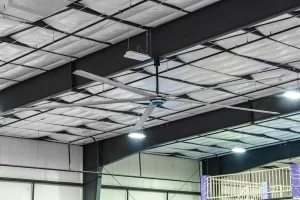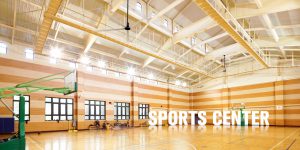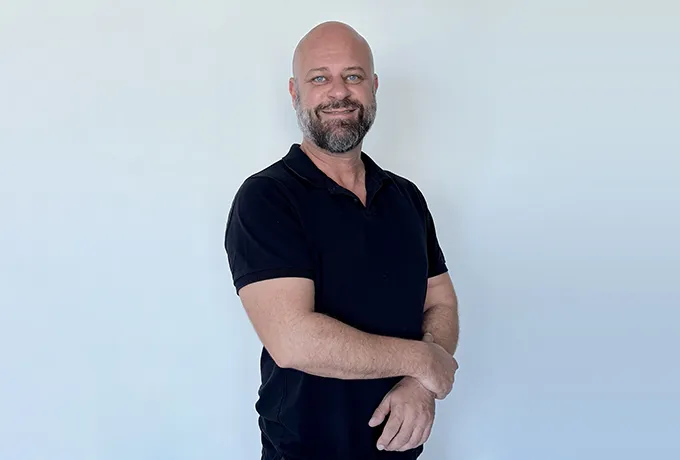Stuffy air and overheated rooms reduce comfort and productivity. This problem escalates when computer or equipment temperatures soar, risking damage and downtime. Luckily, the right fan layout can solve these issues, delivering a refreshing breeze and stable airflow that keeps occupants and devices consistently cool.
The best way to cool your space and PC is by balancing intake and exhaust. Arrange intake fans on the front or bottom of the case to pull cool air in, and set an exhaust fan at the rear or top to remove the hot air. This optimized fan setup maintains efficient airflow, resulting in stable temperatures.

fan layout example
Airflow is the lifeblood of any cooling system, whether you’re using fans in a giant warehouse or inside your pc case at home. From my experience in the HVLS fans manufacturing industry, I’ve seen how proper airflow helps factories, commercial buildings, sports centers, gyms, schools, and warehouses maintain comfortable temperatures while reducing energy bills.
Even if you’re dealing with a pc airflow scenario, the basics remain the same: you want cool air to move across critical components and hot air to exit efficiently. Large HVLS fans accomplish this on a bigger scale, circulating massive volume of air gently throughout an open area. Meanwhile, in a PC, multiple smaller case fan units replicate the effect but in a confined space.
Exhaust mechanisms remove hot air from a room or pc case. Think of it like opening a window in a stuffy room. Without an exhaust fan, hot air lingers, forcing temperatures upward and making it harder to maintain comfort. In a PC environment, you might see a rear exhaust or top fan configuration to dispel rising heat.
At our HVLS manufacturing plant, we often guide factories and sports centers to incorporate exhaust openings near the ceiling. Rising heat escapes, while cooler air stays at occupant level. For a PC, rear exhaust is especially popular. By strategically placing 1 rear exhaust or even top and rear fans exhaust, you create an effective path for warmth to exit. This synergy allows for steady air movement inside your PC or across an entire facility.
A successful fan setup hinges on balanced intake and exhaust. If intake and exhaust fans aren’t coordinated, you end up with too much negative pressure or too much positive airflow. Negative pressure means you’re pulling in unfiltered air through unsealed gaps. Positive airflow can mean you push too much air in without effectively letting it out.
For large rooms, rely on high-volume fans that push air from outside or recirculate interior air thoroughly. HVLS solutions manage the amount of cool air near occupant level, while smaller facilities might turn to standard fans. For PC enthusiasts, you often see a front fan or multiple fans pulling cool air directly into the system, accompanied by one or another fan in the rear or top to remove the hot air.
In a commercial sense, the number of fans used is crucial. Some factories might have a lot of fans, but if they’re arranged poorly, certain zones remain stifling. Similarly, in a computer, you can have many fans, but if they all blow inward without an exhaust fan, temperatures rise.
As an HVLS fan manufacturer, I work with facility managers who ask: “How do I cool down a room this big?” The short answer is: fans don’t cool rooms in the sense that they lower ambient temperature, but they create airflow that makes occupants or equipment feel cooler. By producing a gentle breeze, HVLS fans expedite sweat evaporation for people, or enhance the dissipation of heat from machinery.
We help you put a fan where it can recirculate air effectively. In gymnasiums or industrial production lines, fans can be placed overhead to push refreshing air downward. If you’re dealing with a huge area, multiple fans may be needed for consistent coverage.
For personal computers, you want the best fan setup that fits your pc airflow guide. Typically, you have intake fans on the front or bottom of your case, pulling cool air from the outside. You pair that with one exhaust fan or more at the rear or top to push out heat. Ensuring your gpu and cpu are adequately cooled is key—some people even incorporate an aio liquid cooler or a radiator in the front of the case, so fresh air from outside hits it first.

HVLS fan layout in large Spaces
A case fan is almost always a good idea for tight PC enclosures because you need to let cool air in and hot air out. That said, small or specialized builds sometimes operate without a traditional case fan. They rely on passive cooling or external airflow, but that’s uncommon. From a large-scale perspective, I’ve rarely seen a factory without a dedicated ventilation system or fan solution—be it exhaust vents or overhead HVLS units.
Best pc performance and reliability in personal computers often come from even a single fan that’s well-placed to manage heat. But for commercial or industrial spaces, we frequently advise a common fan approach—multiple overhead fans—and possibly smaller, targeted exhaust vents. If you’re inside your pc building a new system, it’s wise to factor in at least one large 120mm fan or even bigger, such as a 140mm, to maintain steady circulation.
Yes! Placing an exhaust fan at the rear is a classic strategy. Heat naturally travels upward and backward with front-to-back airflow, making a rear fan extremely effective. This configuration pairs well with a front intake fan, letting cool air flow in. Then, the back fan quickly removes the hot air.
Case Study
On the industrial side, we encourage a similar principle. Large HVLS fans create a forward-moving column of air that displaces warm air at occupant level, then specialized vents or smaller fans direct hot air out. This synergy helps keep large spaces comfortable without relying solely on air conditioning.
Your cpu and gpu generate the most heat inside your pc. Their location influences how effectively you can direct cool air across them. For example, if your gpu is near the bottom of the motherboard, having intake fans on the bottom of your case helps deliver direct cooling. Meanwhile, a cpu that’s overclocked or subjected to heavy loads might benefit from a top-mounted radiator or a robust air cooler if it’s placed near the middle or top of the motherboard.
When we handle big ventilation projects, we look at significant heat sources—like large machines or ovens in a factory. Similar to a graphics card or cpu, these devices produce a lot of heat. We typically position HVLS fans overhead to push cooler ambient air down, ensuring that hot zones don’t build up around vital equipment.
Proper fan configuration isn’t just about more fans—it’s about strategic orientation, location, and synergy. In a PC context, you can do a simple test: place a piece of paper near the front of the fan to see if air is pulling in or blowing out. This reveals your fan orientation in seconds, ensuring you have your fans in the front as intake and your top or rear units for exhaust.
In a factory, you might monitor air flow patterns by measuring temperature gradients at different heights. If you notice stagnation in a corner or near a specific machine, you might relocate a smaller directional fan or adjust HVLS fans to reduce that dead zone.
Fan orientation dictates whether a fan is pushing air into or out of a system. The fan blades typically have a curved side that indicates the direction of the airflow. The front of the fan is generally where air enters, and it exhausts out the back. With PC fans, the grill or support arms often mark the exhaust side.
Place the fan in a way that capitalizes on natural convection. Hot air rises, so a top of your case placement is ideal for exhausting heat. Meanwhile, the front or bottom intakes let air from outside your enclosure in. For industrial fans, aim to position them overhead in open spaces, ensuring minimal obstructions so you can achieve better airflow.
Pro Tip for Larger Spaces: If you have a mesh front or wide-open area, you allow a decent amount of cool air to pass through without restriction. But if your building or PC case has restricted front panels, your fans may struggle to draw enough cool air inside. Always check for obstacles that hamper your fan’s performance.
Case airflow in a PC is akin to overall ventilation in a warehouse. The fundamentals remain the same: you want a balanced flow of cool air in and a path for the warm air to exit. A thorough approach to airflow in your pc can be scaled up to entire buildings:
I represent an HVLS fans manufacturing facility that focuses on robust, high-volume, low-speed fans for factories, commercial centers, sports arenas, gyms, schools, and warehouses. While pc enthusiast communities deal with pc fan setup, we address bigger challenges: controlling temperature and airflow over thousands of square feet. Despite the scale difference, the same principle remains—fans don’t technically reduce ambient temperature, but they let cool air circulate around people and equipment, dramatically improving comfort and performance.

HVLS fan for commercial places
| Placement | PC Build | Large Facility |
|---|---|---|
| Front/Bottom (Intake) | Pulls cool air in (e.g., front intake, intake fans on the bottom) | Doors/windows or ground-level vents for outside air or targeted fans near busy areas |
| Rear/Top (Exhaust) | Rear exhaust, top fan, or top of the case for removing hot air | Ceiling vents, smaller exhaust systems, or dedicated fans near the roof or walls |
| Center | Housing key components: cpu, gpu, radiator for direct airflow | Work zones, machinery or occupant areas needing direct air circulation |
| Side | Some cases allow fans on the side panel for more direct component cooling | In large spaces, HVLS fans at strategic intervals for uniform coverage |
For companies focusing on occupant comfort and cost savings:
If you want to see real examples, check out our HVLS fans for manufacturing plants or HVLS solutions for sports centers, where we detail success stories of how these fans changed the game for large-scale ventilation.
Here’s a simple bar chart representation of how airflow temperature might drop with various fan configuration changes (fictional data, for illustration):
Case Temperature in °C
|
| (1) 1 intake / no exhaust -> 50°C
| (2) 1 intake / 1 exhaust -> 45°C
| (3) 2 intake / 1 exhaust -> 42°C
| (4) 2 intake / 2 exhaust -> 39°C
|_________________________________________
Fan Config Variations
These conceptual numbers highlight how each additional fan, when oriented correctly, can enhance overall cooling performance.
How do I get better airflow in my PC if I have limited fan slots?
Focus on balance. If you only have room for two fans, use front intake and rear exhaust to ensure you bring cool air in and push hot air out. Placing your fans in an optimal front to back pattern ensures consistent air flow.
Should I prioritize a top fan or a rear fan first in a new build?
A rear exhaust is usually the easiest solution if you only have one exhaust slot. A top fan can complement a rear fan, especially if hot air accumulates near the top, but it’s more crucial to have that direct path behind the CPU cooler. If possible, do both.
Do more fans always guarantee lower temperatures?
Not necessarily. The arrangement and fan orientation matter more than the total number of fans. If you place them all as intake, you could create inefficient flow patterns. Similarly, all exhaust with no intake leads to negative pressure issues.
How do HVLS fans compare to standard industrial fans for large buildings?
HVLS fans rotate slowly but move significant air volume, covering wider areas with fewer fans. Static pressure fans or smaller industrial fans can target specific hotspots, but HVLS solutions provide uniform coverage, increased occupant comfort, and synergy with HVAC systems. For more details, check our HVLS vs. traditional fans breakdown.
Which fan layout is ideal for a PC with an AIO Liquid Cooler?
If you have an aio for your cpu, mount the radiator where it can draw cool air from the outside—commonly the front or top. Pair it with at least one rear exhaust to expel hot air. The goal is to ensure your gpu also receives fresh air, so keep your front or bottom intakes available.
Will a single fan in a room help with large heat sources like machines or ovens?
If you’re dealing with industrial heat, a single fan might not cut it. Fans don’t lower the overall temperature; they only improve circulation. Larger installations often benefit from multiple fans, especially HVLS solutions, to create consistent airflow throughout a facility.
Our HVLS fans manufacturing plant serves factories, commercial buildings, sports centers, gyms, schools, warehouses, and manufacturing facilities. These large spaces need effective airflow to cool air effectively and drive down operational costs. HVLS fans:
If you’re a facility manager or a building owner seeking to keep your pc rooms and large open areas well-ventilated, we invite you to explore our HVLS product line. Our specialized solutions might be your secret weapon in controlling temperature, humidity, and occupant comfort.
Thank you for reading our pc airflow guide and real-world tips for large-space ventilation. By combining a thoughtful fan layout, whether for your personal rig or an extensive facility, you achieve cooler, safer, and more productive environments for everyone. We’re here to help with all your fan and ventilation needs—just reach out to get started!

Hi, I’m Michael Danielsson, CEO of Vindus Fans, with over 15 years of experience in the engineering and design industry. I’m here to share what I’ve learned. If you have any questions, feel free to contact me at any time. Let’s grow together!